Positive Effect of Cold Atmospheric Nitrogen Plasma on the Behavior of Mesenchymal Stem Cells Cultured on a Bone Scaffold Containing Iron Oxide-Loaded Silica Nanoparticles Catalyst
Abstract
:1. Introduction
2. Results and Discussion
2.1. Characterization of Produced NPs
2.2. Biocompatibility Screening Tests on the NPs-Loaded Biomaterials
2.3. Characterization of the Selected NPs-Loaded Biomaterials
2.4. Plasma-Induced Production of OH radicals by NPs-Loaded Biomaterials
2.5. Plasma Effect on Stem Cell Behavior Cultured on the NPs-Loaded Biomaterials
3. Materials and Methods
3.1. Silica NPs Synthesis
3.1.1. Preparation of Iron Oxide-Loaded NPs by Dry Impregnation
3.1.2. Characterization of NPs
3.2. Fabrication of NPs-Loaded Biomaterials
3.3. Characterization of NPs-Loaded Biomaterials
3.4. Plasma-Induced Production of OH Radicals by NPs-Loaded Biomaterials
3.5. Cell Culture Experiments
3.5.1. Cytotoxicity of the Biomaterials
3.5.2. Osteoblast Growth on the Biomaterials
3.5.3. Plasma Effect on Proliferation of Stem Cells on the Biomaterials
3.5.4. Plasma Effect on Osteogenic Differentiation of Stem Cells on the Biomaterials
3.6. Statistical Analysis
4. Conclusions
Supplementary Materials
Author Contributions
Funding
Acknowledgments
Conflicts of Interest
Abbreviations
| ADSCs | Adipose tissue-derived mesenchymal stem cells |
| bALP | Bone alkaline phosphatase |
| Col I | Type I collagen |
| CTAC | CetylTrimethylAmmonium chloride |
| FGF-2 | Fibroblast growth factor-2 |
| HA | Hydroxyapatite |
| HBSS | Hanks’ Balanced Salt solution |
| ICP | Inductively coupled plasma |
| GAD | GlidArc plasma reactor |
| MCM-48 | Mobil Composition of Matter No. 48 |
| MIP | Mercury Intrusion Porosimetry |
| MSNPs | Mesoporous silica nanoparticles |
| NPs | Nanoparticles |
| OC | Osteocalcin |
| PBS | Phosphate buffered saline |
| PP | Polypropylene |
| RONS | Reactive oxygen and nitrogen species |
| ROS | Reactive oxygen species |
| SEM | Scanning electron microscopy |
| SSA | Specific surface area |
| TEA | TriEthanolAmine |
| TEM | Transmission electron microscopy |
| TEOS | Tetraethyl orthosilicate |
| XPS | X-ray photoelectron spectroscopy |
| XRD | X-ray diffraction |
References
- Arndt, S.; Unger, P.; Wacker, E.; Shimizu, T.; Heinlin, J.; Li, Y.F.; Thomas, H.M.; Morfill, G.E.; Zimmermann, J.L.; Bosserhoff, A.K.; et al. Cold atmospheric plasma (CAP) changes gene expression of key molecules of the wound healing machinery and improves wound healing in vitro and in vivo. PLoS ONE 2013, 8, e79325. [Google Scholar] [CrossRef] [Green Version]
- Lin, Z.H.; Cheng, K.Y.; Cheng, Y.P.; Tschang, C.Y.T.; Chiu, H.Y.; Yeh, N.L.; Liao, K.C.; Gu, B.R.; Wu, J.S. Acute rat cutaneous wound healing for small and large wounds using Ar/O2 atmospheric-pressure plasma jet treatment. Plasma Med. 2017, 7, 227–244. [Google Scholar] [CrossRef]
- Grigoras, C.; Topala, I.; Nastuta, A.V.; Jitaru, D.; Florea, I.; Badescu, L.; Ungureanu, D.; Badescu, M.; Dumitrascu, N. Influence of atmospheric pressure plasma treatment on epithelial regeneration process. Rom. Rep. Phys. 2011, 56, 54–61. [Google Scholar]
- Haertel, B.; von Woedtke, T.; Weltmann, K.D.; Lindequist, U. Non-thermal atmospheric-pressure plasma possible application in wound healing. Biomol. Ther. 2014, 22, 477–490. [Google Scholar] [CrossRef] [Green Version]
- Cheng, Q.; Lee, B.L.-P.; Komvopoulos, K.; Yan, Z.; Li, S. Plasma Surface Chemical Treatment of Electrospun Poly(l-Lactide) Microfibrous Scaffolds for Enhanced Cell Adhesion, Growth, and Infiltration. Tissue Eng. Part A 2013, 19, 1188–1198. [Google Scholar] [CrossRef] [Green Version]
- Chen, T.F.; Siow, K.S.; Ng, P.Y.; Majlis, B.Y. Enhancing the biocompatibility of the polyurethane methacrylate and off-stoichiometry thiol-ene polymers by argon and nitrogen plasma treatment. Mater. Sci. Eng. C 2017, 79, 613–621. [Google Scholar] [CrossRef] [PubMed]
- Griffin, M.; Palgrave, R.; Baldovino, V.G.; Butler, P.E.; Kalaskar, D.M. Argon plasma improves the tissue integration and angiogenesis of subcutaneous implants by modifying surface chemistry and topography. Int. J. Nanomed. 2018, 13, 6123–6141. [Google Scholar] [CrossRef] [Green Version]
- Sagbas, B. Argon/Oxygen Plasma Surface Modification of Biopolymers for Improvement of Wettability and Wear Resistance. Int. J. Chem. Mol. Nucl. Mater. Metall. Eng. 2016, 10, 889–894. [Google Scholar]
- Canal, C.; Gaboriau, F.; Villeger, S.; Cvelbar, U.; Ricard, A. Studies on antibacterial dressings obtained by fluorinated post-discharge plasma. Int. J. Pharm. 2009, 367, 155–161. [Google Scholar] [CrossRef]
- Dal’Maz Silva, W.; Belmonte, T.; Duday, D.; Frache, G.; Noël, C.; Choquet, P.; Migeon, H.N.; Maliska, A.M. Interaction mechanisms between Ar-O2 post-discharge and biphenyl. Plasma Process. Polym. 2012, 9, 207–216. [Google Scholar] [CrossRef]
- Przekora, A. Current Trends in Fabrication of Biomaterials for Bone and Cartilage Regeneration: Materials Modifications and Biophysical Stimulations. Int. J. Mol. Sci. 2019, 20, 435. [Google Scholar] [CrossRef] [PubMed] [Green Version]
- Labay, C.; Canal, J.M.; Modic, M.; Cvelbar, U.; Quiles, M.; Armengol, M.; Arbos, M.A.; Gil, F.J.; Canal, C. Antibiotic-loaded polypropylene surgical meshes with suitable biological behaviour by plasma functionalization and polymerization. Biomaterials 2015, 71, 132–144. [Google Scholar] [CrossRef] [PubMed]
- Kudryavtseva, V.; Stankevich, K.; Gudima, A.; Kibler, E.; Zhukov, Y.; Bolbasov, E.; Malashicheva, A.; Zhuravlev, M.; Riabov, V.; Liu, T.; et al. Atmospheric pressure plasma assisted immobilization of hyaluronic acid on tissue engineering PLA-based scaffolds and its effect on primary human macrophages. Mater. Des. 2017, 127, 261–271. [Google Scholar] [CrossRef]
- Tominami, K.; Kanetaka, H.; Sasaki, S.; Mokudai, T.; Kaneko, T.; Niwano, Y. Cold atmospheric plasma enhances osteoblast differentiation. PLoS ONE 2017, 12, e0180507. [Google Scholar] [CrossRef] [PubMed]
- Przekora, A.; Pawlat, J.; Terebun, P.; Duday, D.; Canal, C.; Hermans, S.; Audemar, M.; Labay, C.; Thomann, J.S.; Ginalska, G. The effect of low temperature atmospheric nitrogen plasma on MC3T3-E1 preosteoblast proliferation and differentiation in vitro. J. Phys. D. Appl. Phys. 2019, 52, 275401. [Google Scholar] [CrossRef]
- Arai, M.; Shibata, Y.; Pugdee, K.; Abiko, Y.; Ogata, Y. Effects of reactive oxygen species (ROS) on antioxidant system and osteoblastic differentiation in MC3T3-E1 cells. IUBMB Life 2007, 59, 27–33. [Google Scholar] [CrossRef]
- Takamatsu, T.; Uehara, K.; Sasaki, Y.; Miyahara, H.; Matsumura, Y.; Iwasawa, A.; Ito, N.; Azuma, T.; Kohno, M.; Okino, A. Investigation of reactive species using various gas plasmas. RSC Adv. 2014, 4, 39901–39905. [Google Scholar] [CrossRef] [Green Version]
- Bello, M.; Abdul Raman, A.A.; Asghar, A. A review on approaches for addressing the limitations of Fenton oxidation for recalcitrant wastewater treatment. Process. Saf. Environ. Prot. 2019, 126, 119–140. [Google Scholar] [CrossRef]
- Palas, B.; Ersöz, G.; Atalay, S. Bioinspired metal oxide particles as efficient wet air oxidation and photocatalytic oxidation catalysts for the degradation of acetaminophen in aqueous phase. Ecotoxicol. Environ. Saf. 2019, 182, 109367. [Google Scholar] [CrossRef]
- Dhakshinamoorthy, A.; Navalon, S.; Alvaro, M.; Garcia, H. Metal nanoparticles as heterogeneous fenton catalysts. ChemSusChem 2012, 5, 46–64. [Google Scholar] [CrossRef]
- Kazimierczak, P.; Benko, A.; Palka, K.; Canal, C.; Kolodynska, D.; Przekora, A. Novel synthesis method combining a foaming agent with freeze-drying to obtain hybrid highly macroporous bone scaffolds. J. Mater. Sci. Technol. 2020, 43, 52–63. [Google Scholar] [CrossRef]
- Przekora, A. The summary of the most important cell-biomaterial interactions that need to be considered during in vitro biocompatibility testing of bone scaffolds for tissue engineering applications. Mater. Sci. Eng. C 2019, 97, 1036–1051. [Google Scholar] [CrossRef] [PubMed]
- Przekora, A.; Palka, K.; Ginalska, G. Biomedical potential of chitosan/HA and chitosan/β-1,3-glucan/HA biomaterials as scaffolds for bone regeneration—A comparative study. Mater. Sci. Eng. C 2016, 58, 891–899. [Google Scholar] [CrossRef]
- Hannink, G.; Arts, J.J.C. Bioresorbability, porosity and mechanical strength of bone substitutes: What is optimal for bone regeneration? Injury 2011, 42 (Suppl. 2), S22–S25. [Google Scholar] [CrossRef] [PubMed] [Green Version]
- Bruggeman, P.; Kushner, M.; Locke, B.; Gardeniers, J.; Graham, W.; Graves, D.; Hofman-Caris, R.; Maric, D.; Reid, J.; Ceriani, E.; et al. Plasma-liquid interactions: A review and roadmap. Plasma Sources Sci. Technol. 2016, 25, 053002. [Google Scholar] [CrossRef]
- Louit, G.; Foley, S.; Cabillic, J.; Coffigny, H.; Taran, F.; Valleix, A.; Renault, J.P.; Pin, S. The reaction of coumarin with the OH radical revisited: Hydroxylation product analysis determined by fluorescence and chromatography. Radiat. Phys. Chem. 2005, 72, 119–124. [Google Scholar] [CrossRef]
- Uchida, G.; Takenaka, K.; Takeda, K.; Ishikawa, K.; Hori, M.; Setsuhara, Y. Selective production of reactive oxygen and nitrogen species in the plasma-treated water by using a nonthermal high-frequency plasma jet. Jpn. J. Appl. Phys. 2018, 57, 0102B4. [Google Scholar] [CrossRef] [Green Version]
- Canal, C.; Fontelo, R.; Hamouda, I.; Guillem-Marti, J.; Cvelbar, U.; Ginebra, M.P. Plasma-induced selectivity in bone cancer cells death. Free Radic. Biol. Med. 2017, 110, 72–80. [Google Scholar] [CrossRef] [Green Version]
- Tornin, J.; Mateu-Sanz, M.; Rodríguez, A.; Labay, C.; Rodríguez, R.; Canal, C. Pyruvate Plays a Main Role in the Antitumoral Selectivity of Cold Atmospheric Plasma in Osteosarcoma. Sci. Rep. 2019, 9, 10681. [Google Scholar] [CrossRef] [Green Version]
- Kalghatgi, S.; Friedman, G.; Fridman, A.; Clyne, A.M. Endothelial cell proliferation is enhanced by low dose non-thermal plasma through fibroblast growth factor-2 release. Ann. Biomed. Eng. 2010, 38, 748–757. [Google Scholar] [CrossRef]
- Shimoaka, T.; Ogasawara, T.; Yonamine, A.; Chikazu, D.; Kawano, H.; Nakamura, K.; Itoh, N.; Kawaguchi, H. Regulation of osteoblast, chondrocyte, and osteoclast functions by fibroblast growth factor (FGF)-18 in comparison with FGF-2 and FGF-10. J. Biol. Chem. 2002, 277, 7493–7500. [Google Scholar] [CrossRef] [Green Version]
- Chikazu, D.; Katagiri, M.; Ogasawara, T.; Ogata, N.; Shimoaka, T.; Takato, T.; Nakamura, K.; Kawaguchi, H. Regulation of osteoclast differentiation by fibroblast growth factor 2: Stimulation of receptor activator of nuclear factor κB ligand/osteoclast differentiation factor expression in osteoblasts and inhibition of macrophage colony-stimulating factor functi. J. Bone Miner. Res. 2001, 16, 2074–2081. [Google Scholar] [CrossRef] [PubMed]
- Dupree, M.A.; Pollack, S.R.; Levine, E.M.; Laurencin, C.T. Fibroblast growth factor 2 induced proliferation in osteoblasts and bone marrow stromal cells: A whole cell model. Biophys. J. 2006, 91, 3097–3112. [Google Scholar] [CrossRef] [PubMed] [Green Version]
- Mao, L.; Xia, L.; Chang, J.; Liu, J.; Jiang, L.; Wu, C.; Fang, B. The synergistic effects of Sr and Si bioactive ions on osteogenesis, osteoclastogenesis and angiogenesis for osteoporotic bone regeneration. Acta Biomater. 2017, 61, 217–232. [Google Scholar] [CrossRef] [PubMed]
- Jeney, V. Clinical impact and cellular mechanisms of iron overload-associated bone loss. Front. Pharm. 2017, 8, 77. [Google Scholar] [CrossRef]
- Yamasaki, K.; Hagiwara, H. Excess iron inhibits osteoblast metabolism. Toxicol. Lett. 2009, 191, 211–215. [Google Scholar] [CrossRef] [PubMed]
- Yang, J.; Zhang, J.; Ding, C.; Dong, D.; Shang, P. Regulation of Osteoblast Differentiation and Iron Content in MC3T3-E1 Cells by Static Magnetic Field with Different Intensities. Biol. Trace Elem. Res. 2018, 184, 214–225. [Google Scholar] [CrossRef] [Green Version]
- Schumacher, K.; Grün, M.; Unger, K.K. Novel synthesis of spherical MCM-48. Microporous Mesoporous Mater. 1999, 27, 201–206. [Google Scholar] [CrossRef]
- Möller, K.; Kobler, J.; Bein, T. Colloidal suspensions of nanometer-sized mesoporous silica. Adv. Funct. Mater. 2007, 17, 605–612. [Google Scholar] [CrossRef]
- Kobler, J.; Möller, K.; Bein, T. Colloidal suspensions of functionalized mesoporous silica nanoparticles. ACS Nano 2008, 2, 791–799. [Google Scholar] [CrossRef]
- Van Espen, P.; Van Grieken, R.; Markowicz, A. Handbook of X-Ray Spectrometry: Methods and Techniques; Marcel Dekker: New York, NY, USA, 1993. [Google Scholar]
- Osán, J.; De Hoog, J.; Van Espen, P.; Szalóki, I.; Ro, C.U.; Van Grieken, R. Evaluation of energy-dispersive x-ray spectra of low-Z elements from electron-probe microanalysis of individual particles. X-Ray Spectrom. 2001, 30, 419–426. [Google Scholar] [CrossRef]
- Kyotani, T.; Koshimizu, S. Identification of Individual Si-Rich Particles Derived from Kosa Aerosol by the Alkali Elemental Composition. Bull. Chem. Soc. Jpn. 2001, 74, 723–729. [Google Scholar] [CrossRef]
- Boon, G.; Bastin, G. Quantitative analysis of thin specimens in the TEM using a φ(ρz)-model. Microchim. Acta 2004, 147, 125–133. [Google Scholar] [CrossRef]
- Bastin, G.F.; Dijkstra, J.M.; Heijligers, H.J.M. PROZA96: An Improved Matrix Correction Program for Electron Probe Microanalysis, Based on a Double Gaussian φ(pz) Approach. X-ray Spectrom. 1998, 27, 3–10. [Google Scholar] [CrossRef]
- Przekora, A.; Ginalska, G. Enhanced differentiation of osteoblastic cells on novel chitosan/β-1,3-glucan/bioceramic scaffolds for bone tissue regeneration. Biomed. Mater. 2015, 10. [Google Scholar] [CrossRef]
- Przekora, A.; Palka, K.; Ginalska, G. Chitosan/β-1,3-glucan/calcium phosphate ceramics composites-Novel cell scaffolds for bone tissue engineering application. J. Biotechnol. 2014, 182–183, 46–53. [Google Scholar] [CrossRef]
- Pawłat, J.; Terebun, P.; Kwiatkowski, M.; Tarabová, B.; Kovaľová, Z.; Kučerová, K.; Machala, Z.; Janda, M.; Hensel, K. Evaluation of Oxidative Species in Gaseous and Liquid Phase Generated by Mini-Gliding Arc Discharge. Plasma Chem. Plasma Process. 2019, 39, 627–642. [Google Scholar] [CrossRef] [Green Version]
- Kazimierczak, P.; Kolmas, J.; Przekora, A. Biological response to macroporous chitosan-agarose bone scaffolds comprising Mg-and Zn-doped nano-hydroxyapatite. Int. J. Mol. Sci. 2019, 20, 3835. [Google Scholar] [CrossRef] [Green Version]


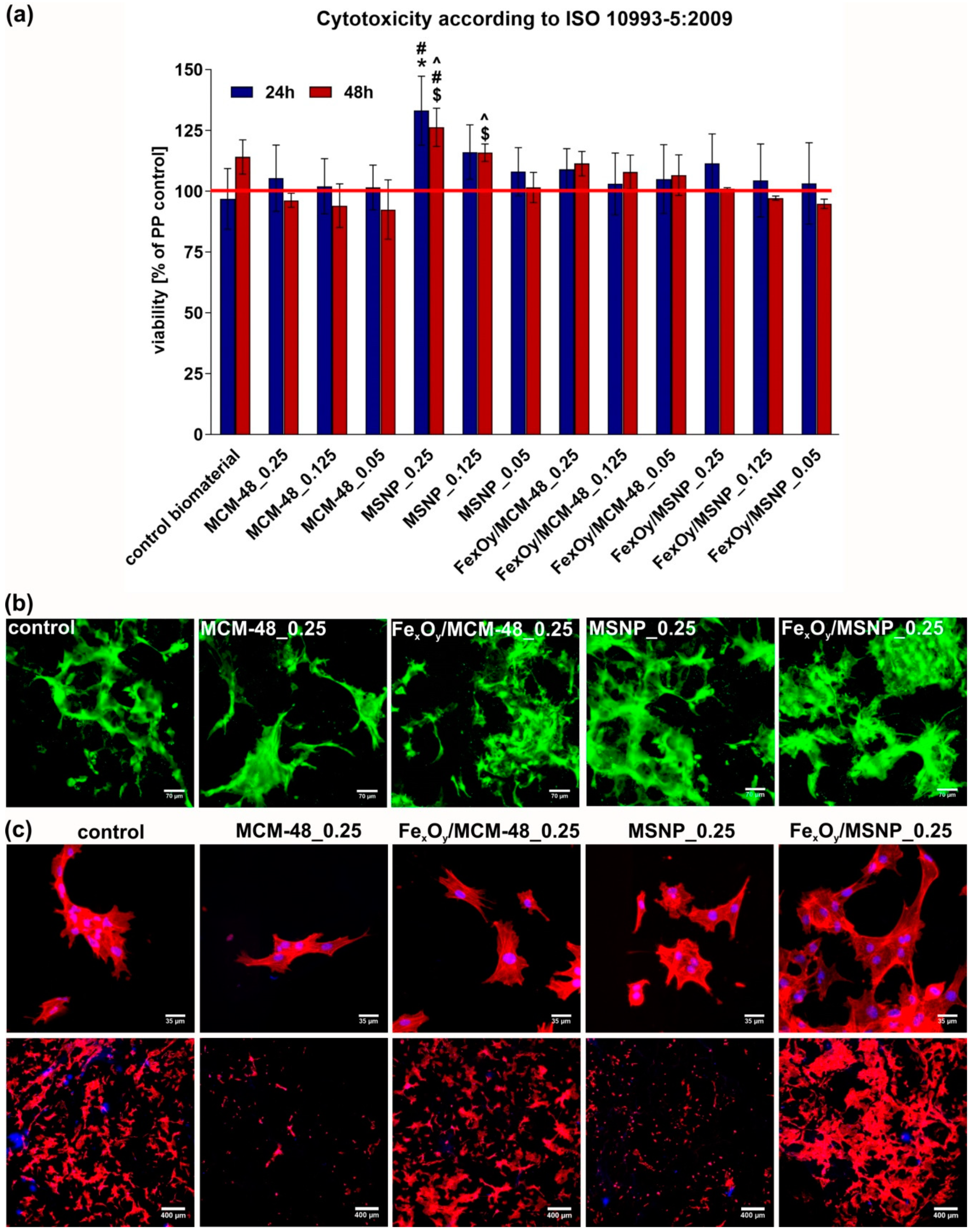

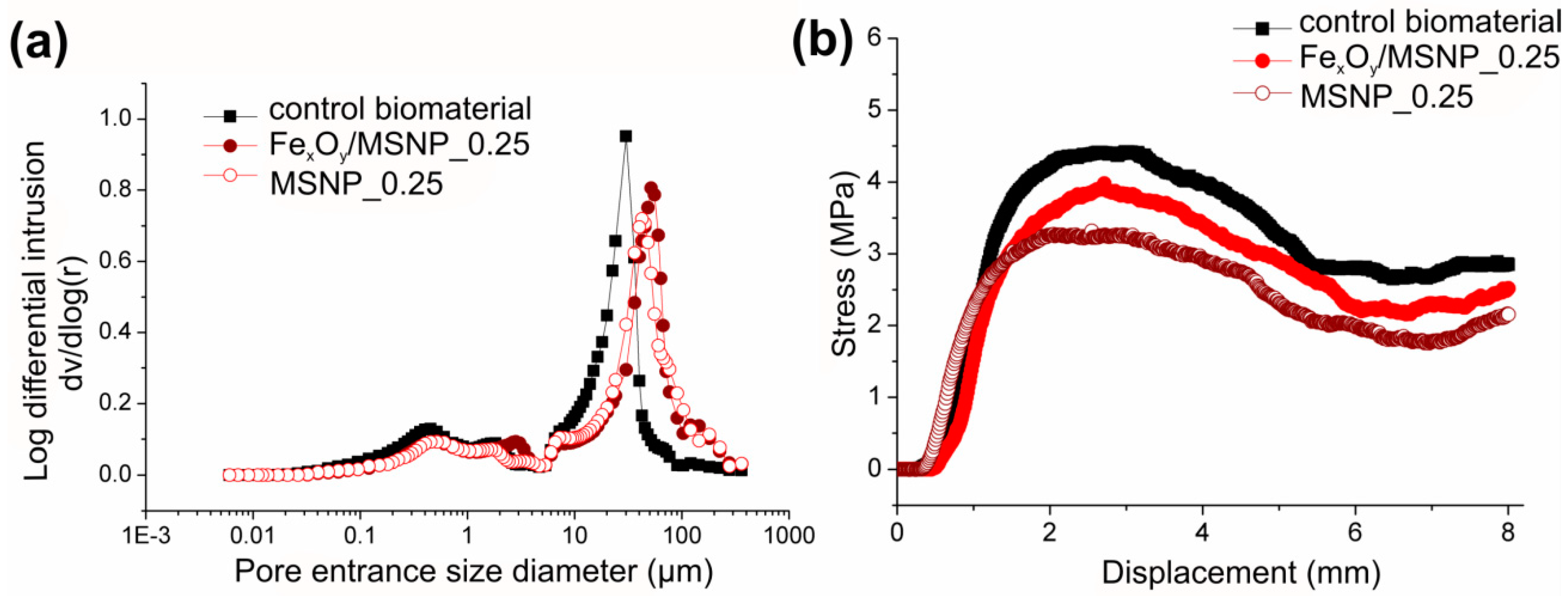
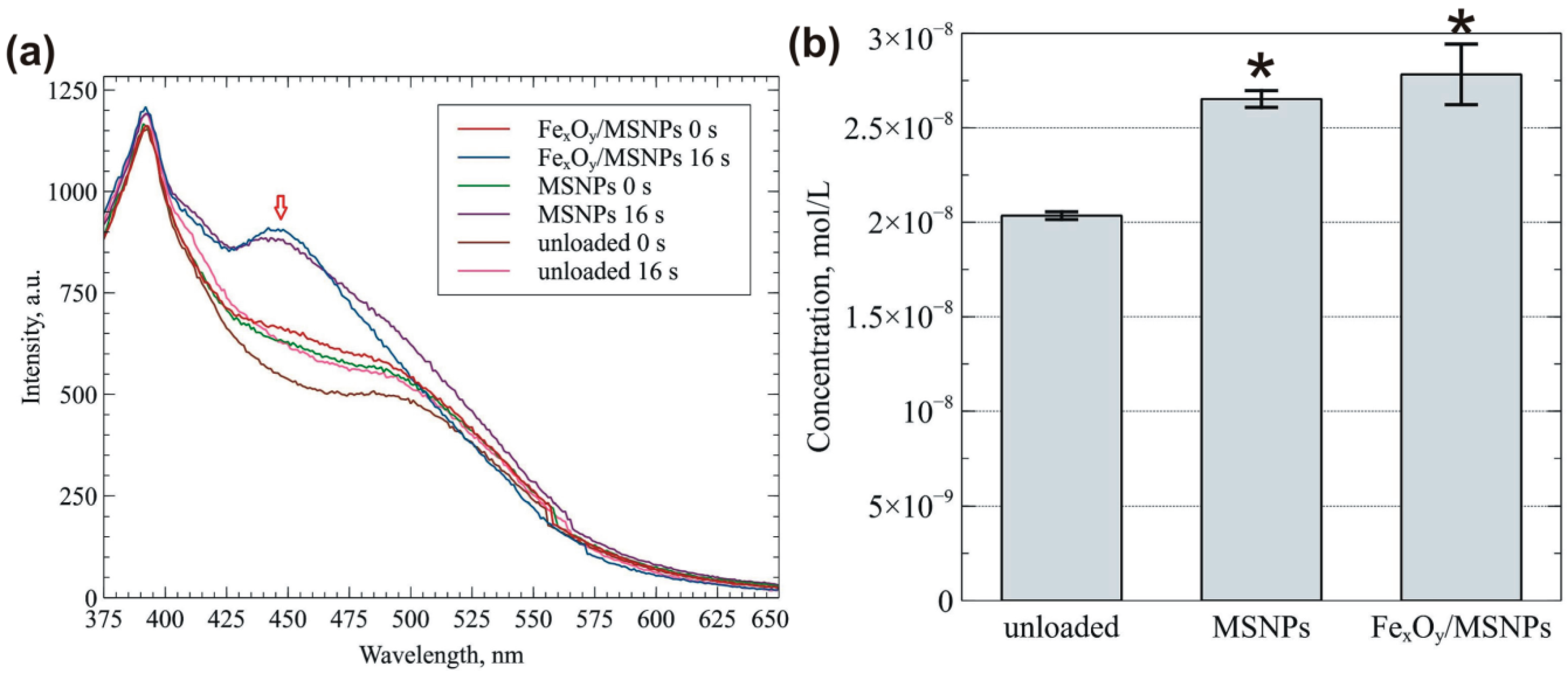
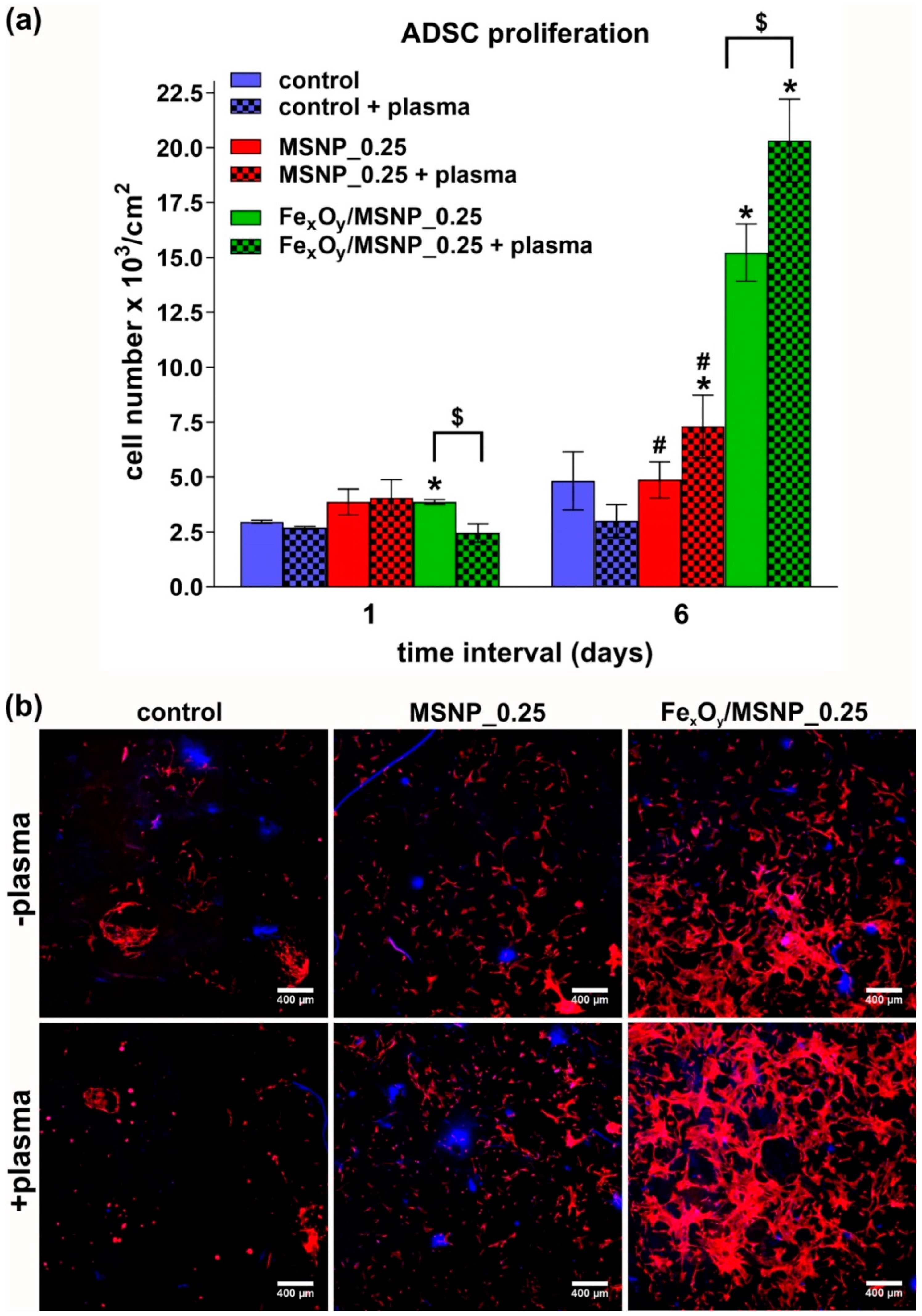
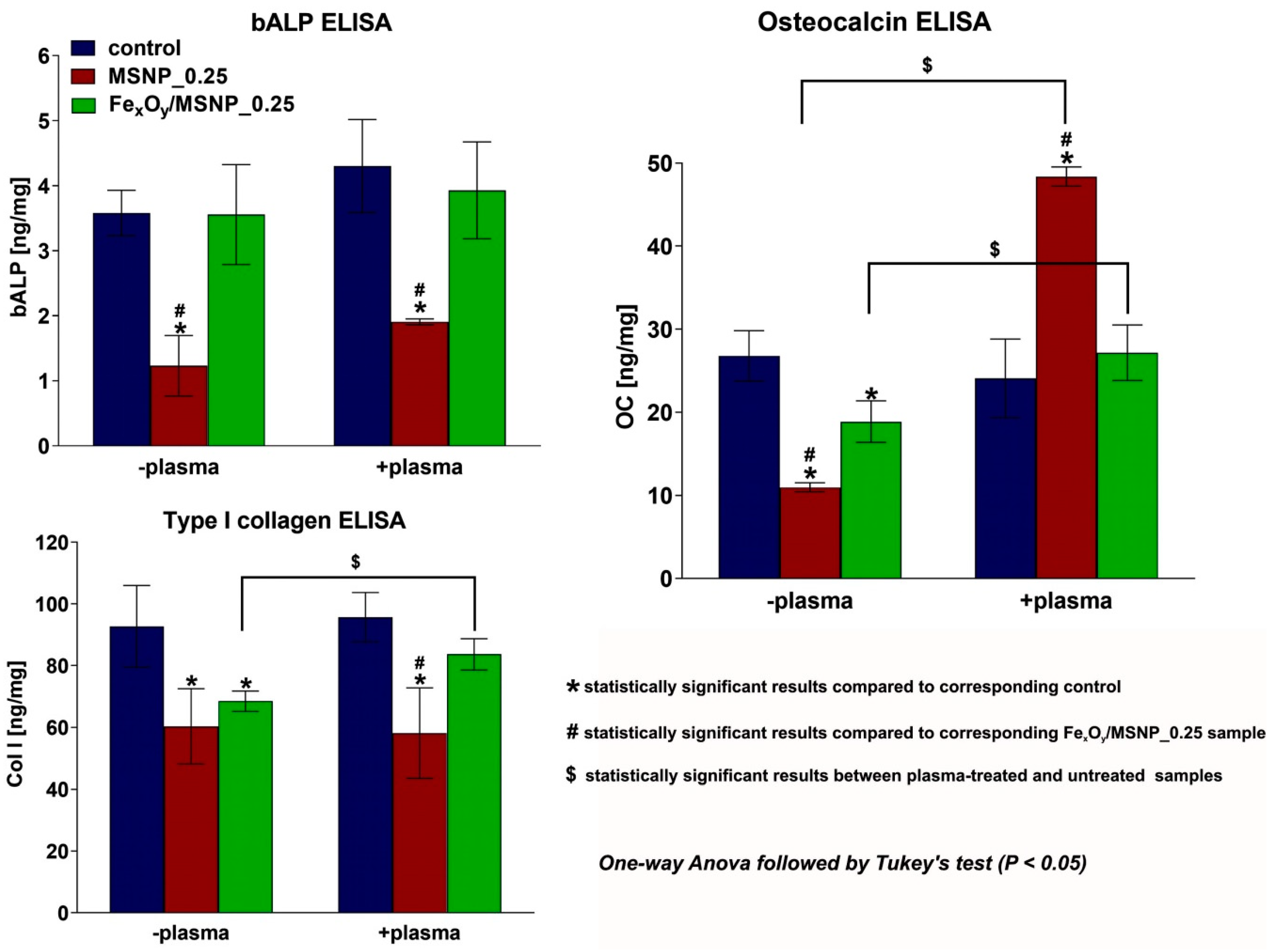
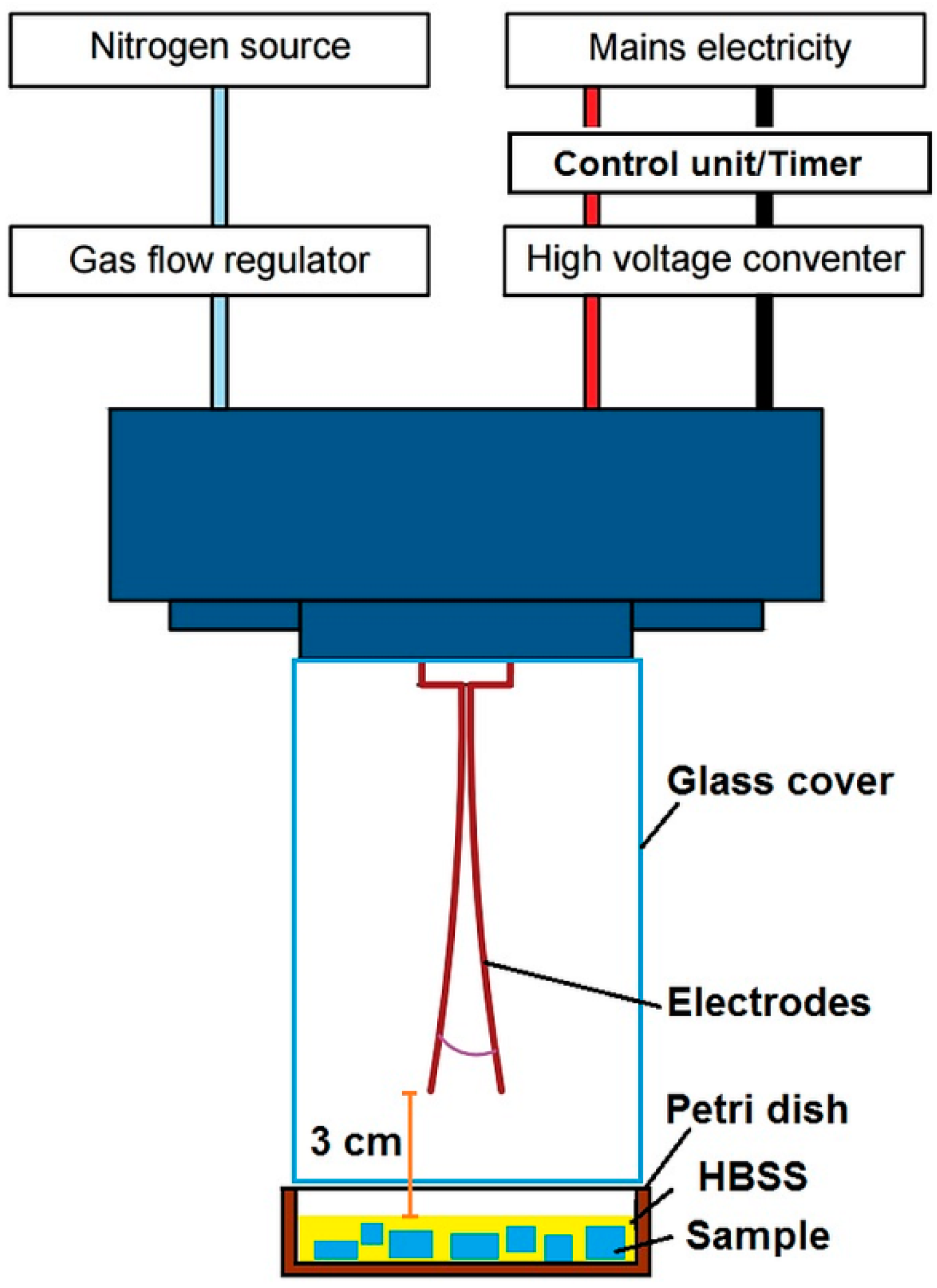
| FexOy/MCM-48 | FexOy/MSNPs | MCM-48 | MSNPs | |
|---|---|---|---|---|
| O 1s | 64.24 | 68.80 | 68.99 | 60.50 |
| Si 2p | 33.41 | 29.18 | 29.74 | 30.87 |
| O/Si | 1.92 | 2.36 | 2.32 | 1.96 |
| Fe 2p3/2 | 0.32 | 0.61 | / | / |
| Fe/Si | 0.01 | 0.02 | / | / |
| C 1s | 2.03 | 1.41 | 1.27 | 8.63 |
| Reference | Total Porosity (%) | Young’s Modulus (GPa) | WOF (MPa.m1/2) |
|---|---|---|---|
| Control Biomaterial | 50.1 | 3.92 ± 0.75 | 1.72 ± 0.24 |
| MSNPs_0.25 | 50.4 | 3.68 ± 0.78 | 1.63 ± 0.39 |
| FexOy/MSNPs_0.25 | 50.2 | 3.18 ± 0.10 | 1.42 ± 0.21 |
© 2020 by the authors. Licensee MDPI, Basel, Switzerland. This article is an open access article distributed under the terms and conditions of the Creative Commons Attribution (CC BY) license (http://creativecommons.org/licenses/by/4.0/).
Share and Cite
Przekora, A.; Audemar, M.; Pawlat, J.; Canal, C.; Thomann, J.-S.; Labay, C.; Wojcik, M.; Kwiatkowski, M.; Terebun, P.; Ginalska, G.; et al. Positive Effect of Cold Atmospheric Nitrogen Plasma on the Behavior of Mesenchymal Stem Cells Cultured on a Bone Scaffold Containing Iron Oxide-Loaded Silica Nanoparticles Catalyst. Int. J. Mol. Sci. 2020, 21, 4738. https://doi.org/10.3390/ijms21134738
Przekora A, Audemar M, Pawlat J, Canal C, Thomann J-S, Labay C, Wojcik M, Kwiatkowski M, Terebun P, Ginalska G, et al. Positive Effect of Cold Atmospheric Nitrogen Plasma on the Behavior of Mesenchymal Stem Cells Cultured on a Bone Scaffold Containing Iron Oxide-Loaded Silica Nanoparticles Catalyst. International Journal of Molecular Sciences. 2020; 21(13):4738. https://doi.org/10.3390/ijms21134738
Chicago/Turabian StylePrzekora, Agata, Maïté Audemar, Joanna Pawlat, Cristina Canal, Jean-Sébastien Thomann, Cédric Labay, Michal Wojcik, Michal Kwiatkowski, Piotr Terebun, Grazyna Ginalska, and et al. 2020. "Positive Effect of Cold Atmospheric Nitrogen Plasma on the Behavior of Mesenchymal Stem Cells Cultured on a Bone Scaffold Containing Iron Oxide-Loaded Silica Nanoparticles Catalyst" International Journal of Molecular Sciences 21, no. 13: 4738. https://doi.org/10.3390/ijms21134738
APA StylePrzekora, A., Audemar, M., Pawlat, J., Canal, C., Thomann, J.-S., Labay, C., Wojcik, M., Kwiatkowski, M., Terebun, P., Ginalska, G., Hermans, S., & Duday, D. (2020). Positive Effect of Cold Atmospheric Nitrogen Plasma on the Behavior of Mesenchymal Stem Cells Cultured on a Bone Scaffold Containing Iron Oxide-Loaded Silica Nanoparticles Catalyst. International Journal of Molecular Sciences, 21(13), 4738. https://doi.org/10.3390/ijms21134738










